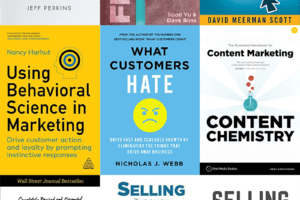???? Episode 106 of Yes, and Marketing
Have you ever wondered…
…what your priority should be as CMO?
…if you have too many direct reports?
…how to make sure your rebrand is more than just a new logo?
…how to tell your CEO that TikTok isn’t a good idea?
CMOs (and marketing leaders of all stripes), this one’s for you.
As the founder of CMO Huddles (the industry’s fastest-growing community of B2B CMOs), Drew Neisser has more insight into the experience and struggles of CMOs than just about anyone. And, as the founder of award-winning boutique agency Renegade, he also has the marketing chops to combine that CMO insight with practical, actionable strategies.
In this interview, he shares the four traits of successful CMOs, why your responsibility is more than just driving leads, and a few key conversations to have with your CEO and CFO. He also explains how to make a rebrand actually work and his litmus test for the content that Renegades produces.
One recurring theme from the conversation? As CMO, you should be focused internally as much (or more than) externally. Building a successful brand has to start with your employees.
Listen to the full interview above or read on for more highlights from the conversation. You can also view excerpts from all our episodes on our show page.
???? Who is Drew Neisser?
Name: Drew Neisser
What he does: Founder of Renegade and CMO Huddles. Author and podcast host.
Find Drew on the web: Renegade | CMO Huddles | LinkedIn | Twitter
Get smart: “Most CMOs will say our priorities are driving leads, and then customers, and then employees. No, no, no. It’s employees, customers, and prospects, in that order.”
???? Episode Highlights
Read verbatim excerpts from our interview with Drew Neisser.
The most contrarian take he’s heard from a CMO
“David Kerner from 75F: His advice was, ‘Don’t do anything your competitors are doing.’ And he has large competitors, or one specifically, so he doesn’t blog, they don’t do social—they put all their money in places where their competitors weren’t. And it’s worked for them.”
(Check out Drew’s interview with David for more renegade practices.)
CATS: the four characteristics of successful CMOs ????
“CATS stands for courageous, artful, thoughtful and scientific. Those are the four characteristics that whenever I talk to successful CMOs, I can always find those traits in there.
I started with courage because I knew that was one. It’s such a through line. You can’t get an organization to focus without courage because you have to say no to somebody—you have to say no to a lot. That takes courage.”
CMOs need fewer direct reports
“A lot of CMOs have too many direct reports.
…If you have more than six direct reports, that’s six one-on-ones. It creates a lot more clutter, and it also means that you have six priorities. What you really want is as CMO is to have three priorities, and then have three people whose job depends on those priorities.”
Being CMO is about more than pipeline
“A lot of CMOs are hired by the CEO with one specific goal: ‘Increase demand.’ That’s it. And, ‘We’re going to measure you on your ability to drive pipeline.’
The sad part of that is yes, every marketer needs to do that, but that’s maybe one-fourth of their job. They can drive employee engagement, endorsement, advocacy. They can drive customer engagement, endorsement, advocacy. They can drive prospect leads, and then there’s this whole world of ‘brand,’ and that has impact for everything that the organization is doing, including recruiting employees, which is such a big problem.
So, the problem simply is that CMOs define their job too narrowly.”
CEOs: What *not* to say to your CMO
“When you go to your CMO and you say, ‘Hey, my kids are on TikTok and I really think we need to have a presence there’—you’ve jumped straight to tactic. You haven’t talked strategy, you haven’t talked business challenge.
And so it takes courage to be able to push back to the CEO and say, ‘Can we up-level that to the strategy that you’re trying to achieve with that tactic? And then we can have a conversation.’”
The conversation to have with your CFO
“It takes courage to go to the CFO and say, ‘Okay, one, I need to understand how we really make money. And two, you need to understand how marketing works so that we can work together to make it a leverageable instrument in your toolkit.’
…Most CFOs say, ‘Ah, this is a cost, not an investment,’ and so you’ve got to educate them.”
How to meet—and exceed—expectations with your B2B customer experience
“So many times in long sales cycles to enterprises, the company that is selling stuff makes it really hard for the customer to buy it. The information that everybody on the buying committee needs just isn’t there. So, did you remove all the friction from the buying process? Did you make it easy?
And then once they bought it—and this is the other part of it—did you make it easy to activate, to train, so that your customer can get the most out of your product or service?
That’s just baseline stuff. That’s meeting expectations. Exceeding expectations is when you really understand what’s going on with your customer, and you are able to offer these little moments of surprise and delight. That’s really an art form, but it means paying attention to the customers.”
How to get hockey stick growth ????
“The domain of the CMO is how employees think about the brand, how customers think about the brand and talk about the brand, and then prospects.
You’ve got those three target audiences, and when they’re all working together—when they have the same story and believe in this story—growth happens. And it happens more on a hockey stick level than on a sort of, ‘Hey, we increased leads by 10% this year.’”
Every brand should have a little-p purpose
“If you’re not a B Corp, you probably shouldn’t be talking about ‘big-P’ Purpose, but you still can find your ‘little-p’ purpose.
…A little-p purpose solves a customer pain point.
Toughbook is a little-p purpose brand. It protects everything in your notebook computer. That’s a pain point for anybody who works in the field. You’re a policeman, you’re a fireman, you’re a soldier, you got a computer now with you. ‘If it takes a bullet, can I keep working?’ Yeah, that’s what Toughbook does. So, it’s little-p purpose, but it’s still very important, and it can unify an organization and certainly can unify a brand.”
Employees have to make your brand promise real
“Let’s say you rebrand and your employees go, ‘That’s a joke. We’re not that.’ It’s dead in the water. It won’t get communicated. It won’t be felt, and your customers will feel it right away. They’ll know ‘Oh, that’s just words. That’s just the marketing people doing their thing.’
And that’s the last thing you want because that’s the biggest problem that marketing has, is that nobody takes you seriously.”
…I love it when brands, when they launch new brand campaigns, they actually train the employees on what this means and how this is going to change their evaluations. And when it starts to change their evaluations, you have your employees’ attention because you’re going to reward the behavior that supports the new brand promise.”
Drew’s litmus test for good content
‘“Here’s the litmus test that we have, and this is a good one: For Renegade, are we creating content that a CMO would find valuable, right now? So a CMO—very specific individual with these challenges—will they find it valuable?
So when you’re creating content, and if you say, ‘I’m going to send this to our most important clients’—not prospects, clients—will they get value out of it?
…Then the last part of this is, would they want to share it with their colleagues or their peers?…That’s the real litmus. ‘Is this good content?’ Yeah, because it’s getting shared with colleagues, with customers, with prospects.”
Test to triumph
“I’m not talking about little tests like AB tests or landing pages. You can do all those things, but I’m talking about testing big plans and having those be as much as 20% of your budget. So if something happens like another pandemic or something else crazy, you have options.
…Think about your big bets and test them, and your team will get excited because you create this culture of innovation.”
His top piece of contrarian marketing advice ????????
“Watch out for personas. They can easily lead you astray.
Let me explain that: So if you have 13 personas and you actually present your brand differently to each of those personas, you will lose on an enterprise sale. You will lose. Gartner did the research—you will lose 2.2 times more than if you had a single brand story.”
????️ Drew Neisser Quotes
“The definition of strategy is essentially knowing what you can say no to.”
“Blocking off time for everything is one of the critical solutions to being more productive.”
“[As a CMO] people will ask you, ‘Can you do that?’ And that’s not the right question. It’s, ‘What must we do?’”
“If your marketing doesn’t inspire any kind of new level of service, it’s probably not a real rebranding. It’s just a re-skinning.”
“Anything that touches the consumer—your customer—needs to have marketing’s imprint.”
“Most CMOs will say our priorities are driving leads, and then customers, and then employees. No, no, no. It’s employees, customers, and prospects, in that order.”
“It’s more important to acquire the right customer than any customer.”
“Don’t get Eeyores as customers.”
???? Learn More
Drew’s favorite Ben Franklin quote: “Well done is better than well said.”
Learn about the American Express campaign Drew mentioned, “Small Business Saturday.”
Read the story behind one of Drew’s favorite campaigns he worked on with the HSBC Bank Cab.
Drew’s recommendations:
- 15 Secrets Successful People Know About Time Management by Kevin Kruse
- Ironclad Brand Strategy with Lindsay Pederson
- Latané Conant at 6sense



